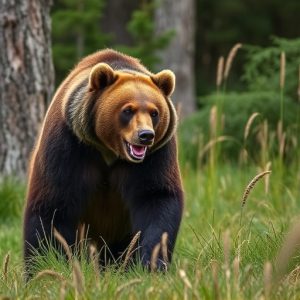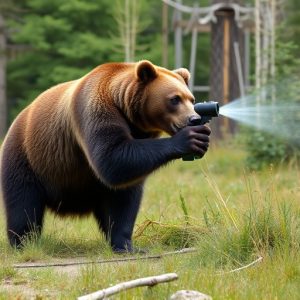Bear Spray Residue: Impact on Wildlife and Safety Best Practices
Bear spray, an effective self-defense tool against black bears, uses capsaicin from chili peppers to…….
Bear spray, an effective self-defense tool against black bears, uses capsaicin from chili peppers to create a protective residue on fur, eyes, and respiratory systems, causing temporary pain and deterring aggression. However, this residue can persist in the environment and impact non-target species such as birds, small mammals, and fish, leading to health issues like respiratory problems and endocrine system disruptions. Responsible usage, including proper aiming, safety measures, maintenance, storage, and disposal, is crucial to minimize unintended wildlife harm caused by bear spray residue.
“Navigating the wild, especially in regions bustling with black bears, requires knowledge of effective defense mechanisms. This article delves into bear spray—a potent tool for personal safety. We explore its effectiveness, dissecting the science behind bear spray residue and its impact on wildlife, including bears and other species. Furthermore, we emphasize safety measures and best practices for users, ensuring responsible usage in the wild. Understanding these aspects is crucial for a safe and harmonious coexistence with nature.”
- Understanding Bear Spray and Its Effectiveness
- The Science Behind Bear Spray Residue
- Impact on Wildlife: Bears and Other Species
- Safety Measures and Best Practices for Users
Understanding Bear Spray and Its Effectiveness
Bear spray, also known as urushiol-based spray, is a specialized self-defense tool designed to deter and repulse black bears. It’s a non-lethal option that works by irritating the bear’s eyes, nose, and respiratory system, creating a strong disincentive to approach. The primary active ingredient in bear spray is capsaicin, derived from chili peppers, which binds to the bear’s nerve endings, causing temporary pain and discomfort.
The effectiveness of bear spray lies in its ability to create a protective barrier between you and the bear. When sprayed, it leaves a residue that can linger on fur, clothing, and even rocks or trees, potentially impacting wildlife other than the intended target. Understanding how bear spray works and following proper usage instructions are crucial for maximizing its effectiveness. In terms of wildlife impact, responsible use of bear spray should minimize residual effects on non-target species, while still deterring bears from approaching humans.
The Science Behind Bear Spray Residue
The effectiveness of bear spray relies heavily on the understanding of its residue and how it interacts with wildlife. When bear spray is discharged, a fine mist of capsaicin-laced liquid is released, which coats the bear’s fur, eyes, and respiratory system. This residue is what causes the aggressive behavior to cease as the bear experiences intense irritation and pain. However, the impact doesn’t stop there; bear spray residue also has implications for the environment and wildlife ecosystem.
Studies have shown that capsaicin, the active ingredient in bear spray, can persist on surfaces for extended periods, even after the initial spray cloud dissipates. This residue may not only affect the targeted bear but also other animals and insects that come into contact with it. The impact on wildlife is a crucial consideration, as it highlights the need for responsible use and proper disposal of bear spray to minimize environmental contamination and ensure the well-being of local ecosystems.
Impact on Wildlife: Bears and Other Species
Bear spray residue can have significant impacts on wildlife, beyond just affecting bears. While bear spray is designed to deter aggressive encounters with black bears, its chemical remnants can also harm other species that come into contact with it. These chemicals can persist in the environment and accumulate in the tissues of animals, leading to various health issues.
Non-target species like birds, small mammals, and even fish can be affected by bear spray residue. For instance, birds might ingest contaminated food or water, leading to respiratory problems or even death. Small mammals and fish can also suffer from internal injuries or disruptions in their endocrine systems due to exposure to the spray’s chemicals. Understanding these impacts is crucial for implementing responsible usage practices to minimize the wildlife impact of bear spray residue.
Safety Measures and Best Practices for Users
When carrying bear spray, it’s crucial to understand that proper usage goes hand in hand with safety measures. Always ensure you have a clear understanding of the product’s range and effectiveness. Bear spray is designed to create a barrier of residual chemicals, known as bear spray residue, which discourages aggressive behavior from bears by irritating their eyes and nasal passage. However, this residue can also impact wildlife other than its intended target if not used responsibly.
Best practices dictate that users should only deploy the spray when facing an immediate threat. Aiming and spraying towards the bear’s face and body will maximize its effectiveness while minimizing the potential reach of residual spray onto non-target animals or the environment. Regularly check expiration dates and storage conditions to maintain optimal performance, as bear spray can degrade over time. Additionally, keep containers out of reach of children and pets to prevent accidental deployment or ingestion, which could have severe health implications due to the pepper spray’s caustic nature.
Bear spray residue plays a significant role in defending against black bears, offering users a valuable tool to deter and minimize potential wildlife encounters. While it is not a foolproof method, understanding its effectiveness and proper usage can significantly impact the safety of individuals hiking or camping in bear country. By following best practices and staying informed about the science behind bear spray, users can ensure they are prepared for any situation, contributing to a more harmonious coexistence between humans and wildlife.


